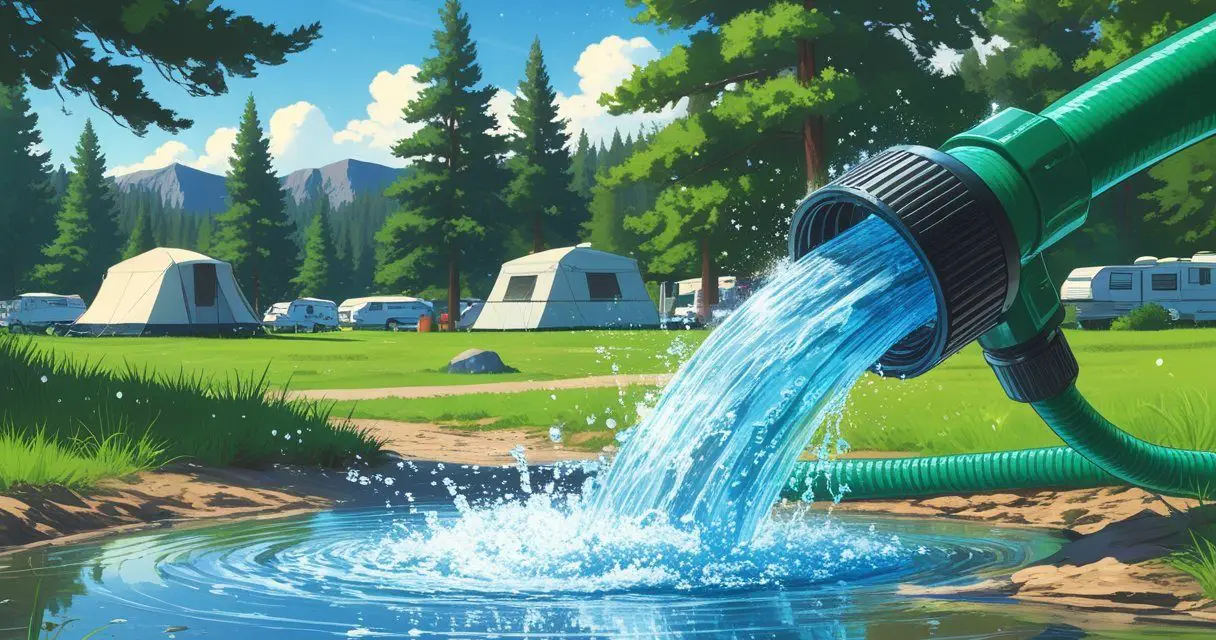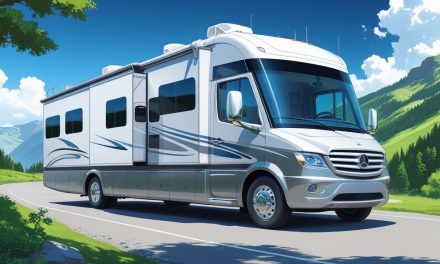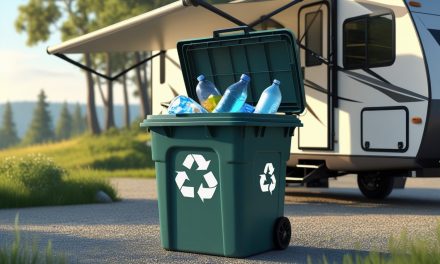Would you like to save this article?
You’ve probably been there before – you pull into your favorite campground, hook up to that suspicious-looking water spigot, and wonder if what’s coming out is actually safe to drink. Campground water quality has become one of the most hotly debated topics in the RV community, and for good reason. The truth is, not all campground water sources are created equal, and some might be harboring surprises you never expected.
Recent studies show that approximately 2 million Americans get sick each year from contaminated drinking water, and campground water systems face unique challenges. Whether you’re a weekend warrior or a full-time RVer, understanding what’s really in that water can make the difference between a great camping experience and a trip to the urgent care. From medieval moat-looking liquid to water that smells like dinosaur eggs, we’ve all encountered questionable H2O on the road.
This comprehensive investigation dives deep into the reality of campground water safety, complete with actual test results that might change how you think about filling your tank forever.
1. The Harsh Reality: Campground Water Isn’t Always What It Seems
You might think that spigot sticking out of the ground like a neglected lawn gnome is providing you with pristine drinking water, but the reality is far more complex. According to the Environmental Protection Agency, there are over 151,000 public water systems in the United States, and many campgrounds operate their own independent systems with varying levels of oversight.
The visual test alone can be alarming – water that looks like it’s been filtered through gym socks and burnt tires isn’t exactly confidence-inspiring. But here’s the kicker: clear water doesn’t always mean safe water, and cloudy water doesn’t always spell disaster.
You’ve probably done the classic RV water ritual: shake off the bugs, hook up the hose, run it for five seconds, and declare it “sterile.” Unfortunately, this approach is about as effective as using a screen door on a submarine.
Water Quality Statistics:
| Issue | Percentage of Systems Affected | Health Impact |
|---|---|---|
| Coliform Bacteria | 7.5% annually | Gastrointestinal illness |
| Lead Contamination | 3.2% of systems | Neurological damage |
| High Mineral Content | 15% of wells | Taste/equipment damage |
2. City Water vs. Well Water: The Great Campground Water Divide
You’ll encounter two main types of campground water systems, each with its own set of challenges and benefits. City water campgrounds connect to municipal systems, which sounds reassuring until you realize that same system might have issued a boil advisory three weeks ago because someone sneezed in the reservoir.
Municipal water systems serve 85% of Americans but face aging infrastructure challenges. The American Society of Civil Engineers gave America’s drinking water infrastructure a C- grade in 2021, with an estimated $473 billion needed for improvements over the next 20 years.
Well water campgrounds present a different set of adventures entirely. These systems often produce water that smells like broken dinosaur eggs soaked in wet pennies, and campground owners will cheerfully tell you “it’s natural” – which technically includes quicksand and poison ivy.
The sulfur smell that makes your shower experience feel like you’re bathing in a boiled fart? That’s hydrogen sulfide gas, and while it’s usually harmless in small concentrations, it’s definitely Mother Nature’s way of saying “proceed with caution.”
3. When Your Dog Refuses the Water Bowl: Warning Signs You Can’t Ignore
Animals have an incredible ability to detect water quality issues that humans might miss, so when Fido looks at his freshly filled bowl and chooses the mud puddle instead, you should probably pay attention. Dogs can smell concentrations of certain compounds at levels 1,000 to 10,000 times lower than humans can detect.
The classic warning signs are hard to miss once you know what to look for:
- Coffee that foams up like a science fair volcano (indicating high mineral content or chemical reactions)
- Water that makes your teeth feel gritty (sediment and mineral buildup)
- Metallic taste that lingers (often indicating iron, manganese, or copper)
Research from the Water Quality Association shows that 85% of the United States has hard water, which can contain dissolved minerals at levels that affect taste and equipment. While hard water isn’t typically dangerous to consume, it can wreak havoc on your RV’s plumbing system and appliances.
You might think you’re being paranoid, but your instincts about water quality are often more accurate than you realize – humans evolved sophisticated mechanisms to detect potentially harmful water sources.
4. The Truth About RV Water Filters: Your First Line of Defense
That inline water filter hanging off your RV might look like a responsible adult decision, but does it actually work? The answer is more nuanced than most RVers realize. Basic inline filters excel at removing sediment, reducing chlorine taste, and filtering out rust – essentially taking your water from “probably not safe” to “it might be fine.”
Standard RV water filters typically use activated carbon and sediment screens, which are effective against:
- Chlorine and chloramine (reducing that pool noodle taste in your coffee)
- Sediment and rust particles (no more orange rings in your cookware)
- Some organic compounds (improving taste and odor)
However, basic filters won’t protect you against bacteria, viruses, or heavy metals like lead. According to NSF International testing standards, you need specialized filtration for these contaminants. The reality is that most RVers use basic filters and hope for the best – a strategy that works most of the time but isn’t foolproof.
Filter Effectiveness Chart:
| Contaminant Type | Basic Carbon Filter | Multi-Stage System | UV Sterilizer |
|---|---|---|---|
| Chlorine | 95% effective | 99% effective | No effect |
| Sediment | 90% effective | 99% effective | No effect |
| Bacteria | 20% effective | 95% effective | 99.9% effective |
| Heavy Metals | 30% effective | 85% effective | No effect |
5. Real Test Results: What We Actually Found in Campground Water
The moment of truth arrived when we put campground water through comprehensive testing using a professional-grade kit that checks for 15 different potential issues. The results might surprise you – both in what we found and what we didn’t find.
The bacteria test (checking for coliform, which basically means poop contamination) came back clean after 72 hours. For this to pass, the test strip needed to remain yellowish rather than turning blue or green, and our sample stayed in the safe zone throughout the testing period.
The lead test was particularly interesting – this heavy metal can cause serious neurological damage, especially in children. Using a precise testing method that required exactly four drops of water and a five-minute wait, our campground water showed two clear lines, indicating lead levels at or below 4 parts per billion (well within EPA safe standards).
pH levels came in at 8.0, which is slightly alkaline but within the EPA’s recommended range of 6.5-8.5. Water with pH levels outside this range can corrode pipes and affect the taste, but our tested water fell comfortably in the acceptable zone.
Complete Test Results:
| Parameter Tested | Result | EPA Standard | Pass/Fail |
|---|---|---|---|
| Coliform Bacteria | Negative | Must be negative | ✅ PASS |
| Lead Content | <4 ppb | <15 ppb | ✅ PASS |
| pH Level | 8.0 | 6.5-8.5 | ✅ PASS |
| Chlorine | Normal | <4 ppm | ✅ PASS |
| Hardness | Moderate | No standard | ℹ️ ACCEPTABLE |
6. The Psychology of Campground Water: Why We Keep Using It Anyway
Despite all our concerns and jokes about medieval moat water, RVers continue to hook up to campground spigots across America – and there’s fascinating psychology behind this behavior. We’ve developed an entire culture around questionable water sources, complete with rituals, filters, and backup plans.
The truth is, we’re willing to accept a certain level of risk because the alternative – carrying all our water – simply isn’t practical for most RV adventures. According to RV Industry Association data, the average RV holds 20-100 gallons of fresh water, which at 8.34 pounds per gallon, represents significant weight and space considerations.
We’ve become masters of risk mitigation rather than risk elimination. We filter the water, ignore suspicious smells, add flavor packets to mask taste issues, and always keep a cooler full of bottled water as backup. This approach reflects the broader RV lifestyle philosophy of accepting calculated risks in exchange for freedom and adventure.
Studies in risk perception show that people are more willing to accept voluntary risks (like choosing to use campground water) versus involuntary risks (like municipal water contamination they can’t control).
7. The Bottom Line: You’re Probably Fine (But Take Precautions Anyway)
After comprehensive testing and analysis, the verdict on campground water safety is surprisingly reassuring – most of the time, you’re probably going to be just fine. The majority of campground water systems meet EPA standards, even if they don’t always meet our aesthetic preferences.
However, “probably fine” isn’t the same as “definitely safe,” and smart RVers take reasonable precautions. The key is understanding that campground water safety exists on a spectrum – some systems are excellent, others are questionable, and a few might genuinely pose health risks.
Your best strategy involves a combination of preparation, filtration, and common sense:
- Invest in quality multi-stage filtration (not just basic inline filters)
- Trust your senses – if water looks, smells, or tastes off, don’t use it for drinking or cooking
- Carry backup water supplies for situations where campground water is genuinely problematic
- Consider portable water testing kits for peace of mind at questionable locations
The brave souls who use campground water to make spaghetti deserve recognition as true pioneers of the RV lifestyle – they’re living proof that with proper precautions and a sense of adventure, you can stay hydrated and healthy on the road.
SOURCES
- Environmental Protection Agency – Safe Drinking Water Act
- CDC – Waterborne Disease & Outbreak Surveillance
- American Society of Civil Engineers – Infrastructure Report Card
- Water Quality Association – Hard Water Statistics
- NSF International – Water Filter Testing Standards
- RV Industry Association – RV Owner Demographics
- The Camping Loop YouTube Channel – Original Video Source






